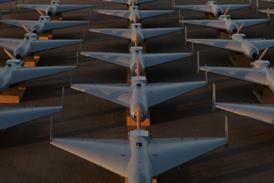David Learmount/LONDON
Flightdeck avionics are supposed to give pilots "situational awareness", but there is evidence that modern systems can reduce it.
Situational awareness is the pilot's mental picture of the aircraft relative to its three-dimensional operational environment, including navigation and terrain, the configuration and safe flight of the aircraft, and the health and mode of operation of its systems.
When the new electronic flight instrument system (EFIS) "glass cockpits" arrived in the early 1980s, with a navigation display and flight management system, the combination looked ideal for improving situational awareness. Pilots had all the information they were used to, plus an integrated moving-map display/weather radar display/compass arc where the compass used to be, and could compute instantly the estimated time of arrival and fuel remaining at any point in the journey ahead. It looked a huge improvement on the raw data with which pilots operate in "classic" cockpits.
In its 1996 report The interface between flightcrews and modern flightdeck systems, however, the US Federal Aviation Administration concluded that introducing human factors into the equation complicates matters, however. British Airways, noting the FAA's and other studies, but also using data from its own SESMA (special event search and master analysis) and BASIS (British Airways Safety Information System) incident databases, decided to compare situational awareness in "glass" and classic cockpits. An abbreviated version has been published by the Flight Safety Foundation.
BA's report concludes: "The evidence is that glass cockpits have not been as successful as had been hoped in improving situational awareness, and degradation of situational awareness-is a serious problem."
The airline says that, having searched BASIS for human factors incidents to see if it indicated any difference in situational awareness between glass and "clockwork" cockpit crews, "all three of the [situational awareness] sub-factors [environmental, mode and systems] were assessed as higher for the clockwork group-Our reports indicate there is no inherent advantage for situational awareness for flightcrews operating glass cockpits."
BA analysed ground proximity warning alerts at night or in instrument meteorological conditions, all of which occurred on approach and were triggered by terrain closure rate. The occurrences ratio, comparing glass cockpit aircraft with "clockwork" types, factored for the number of flights by each category, was 3.5 to 1.
Crew-attributable navigation errors were slightly less likely to occur on types with glass cockpits, but BA was disappointed. The airline says: "The improvement is marginal-navigational errors continue to occur." It notes that 30% of the navigational errors were corrected "before they became an event", adding that "crews of clockwork aircraft were twice as likely to detect their error before it became a navigational deviation, whereas crews of glass cockpit aircraft were twice as likely to discover their error after the deviation had taken place."
The reasons are, says BA:
• relocation of the "picture" from the pilot's mind to the navigation display. Only two dimensions are relocated, separating the vertical and horizontal pictures;
• low arousal caused by underload and complacency;
• the compulsive nature of map displays;
• low awareness of autopilot and autothrottle modes and lack of understanding of the modes;
• masking of abnormal situations, particularly low energy states, by the autoflight systems;
• fixation on flight management computer resetting at the expense of other monitoring.
In other words, pilots used to creating and integrating the situational "picture" in their heads by deducing it from raw data become observers instead of participants in monitoring flight progress, BA suggests:
• having an open chart at all times to give context to information on the navigation display ;
• manually tuning and identifying at least one navigation aid during departure and arrival to crosscheck the flight management computer and update the mental model;
• depending on workload, raising the number of manual tasks, such as selecting an autopilot flight director system mode change, or announcing mode changes vocally. "More verbal interaction between the pilots would increase the levels of arousal as well as providing a cross-check of the two pilots' mental models."
• compensating for the lack of vertical information on the navigation display must be based on "discipline and airmanship", but procedures should include relating actual and required altitudes to the map display.
BA agrees with other studies that an array of special skills is required to operate EFIS aircraft, but until recently these have not been analysed and taught.
Source: Flight International























